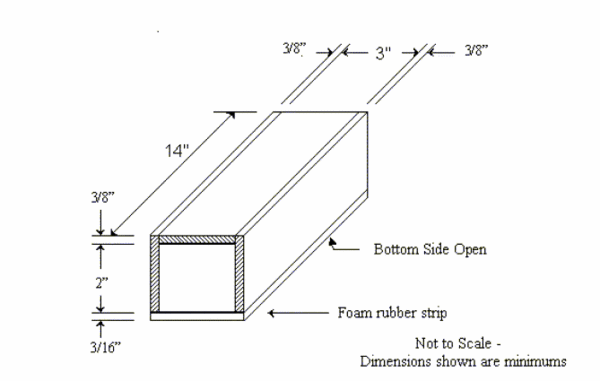106.3.2.20 TM-20, Measurement of Air, Surface or Bituminous Mixture Temperature
This method describes the equipment and procedures required to determine air temperature, surface temperature of a base or pavement, and bituminous mixture temperature in the loose state.
106.3.2.20.1 Apparatus
Infrared Thermometer. Used for surface and loose bituminous mixture temperature determination. The thermometer should register in the range of 20° F to 400° F, with a maximum increment of 2 °F. Operation of this instrument should be based on the manufacturer’s instructions.
Mercury Thermometer. Used for air or surface temperature determination. Typically a straight glass thermometer or a U-shaped glass thermometer in a plastic housing commonly referred to as a MAX-MIN thermometer. The thermometer should register in the range of 20° F to 130° F, with a maximum increment of 2 °F.
Armored Thermometer. Used for loose bituminous mixture temperature determination. The thermometer should register in the range of 50° F to 400° F, with a maximum increment of 5 °F.
Bi-Therm Dial Thermometer. Used for loose bituminous mixture temperature determination. The thermometer should register in the range of 50° F to 400° F, with a maximum increment of 5 °F.
Spot Check Disc Thermometer. Used for surface temperature determination. The thermometer should register in the range of 32° F to 250° F, with a maximum increment of 2 °F.
Digital Thermometer. Used for air surface or bituminous mixture temperature determination. Thermometer will measure temperature in the range of 0° F to 400° F as a minimum with a maximum increment of 1° F. Thermometer will have a remote probe and may have recording capabilities of maximum and minimum temperature reading. Thermometer, when purchased, shall have a record of calibration to NIST Traceable Standards provided.
Wooden Box. Used to cover a mercury thermometer when determining the temperature of a base or pavement. The box will be wooden with a material thickness of not less than 3/8 in. The minimum inside dimensions will be 2 in. tall, 3 in. wide and 14 in. long. The bottom side of the box is to be left open. The bottom edge of the sides and ends shall have attached a strip of foam rubber 3/16 in. thick and the same width as the thickness of the side and end boards. The outside of the box shall be painted with aluminum paint. See Fig. 106.3.2.1.20, below, for a pictorial description.
Calibration of Thermometers. Thermometers shall be calibrated annually against a known standard.
106.3.2.20.2 Procedure
Air Temperature. The mercury thermometer or digital thermometer probe shall be positioned in a shaded area and shall not be exposed to direct sunlight. The thermometer shall be 4.5 ft. above surface level, measured from the surface to the bulb of the thermometer. Care should be taken to ensure no artificial heating or cooling occurs near the thermometer. The thermometer will be left in this location until the reading stabilizes. Air temperature shall be recorded to the nearest 2 °F.
Surface Temperature, mercury thermometer. The thermometer cannot be disturbed for at least 5 minutes while conducting this test, so select a location where this criteria can be met. Place the thermometer on the test surface and place the wooden box firmly over the thermometer ensuring the foam rubber strips are in contact with the test surface. The box should remain over the thermometer for a minimum of five minutes. After the 5 minutes, tip the box on edge only far enough to read the thermometer. The surface temperature shall be recorded to the nearest 2 °F.
Surface Temperature, infrared thermometer. When using an infrared thermometer, follow the manufacturer's recommended procedure. When obtaining the temperature of a surface, make sure air currents do not affect the reading. The surface temperature shall be recorded to the nearest 2 °F.
Surface Temperature, spot check disc thermometer. Place the thermometer on the surface and wait until the needle stops moving. Read the temperature. The surface temperature should be recorded to the nearest 2 °F.
Surface Temperature, digital thermometer. The thermometer probe cannot be disturbed for at least 5 minutes while conducting this test, so select a location where this criteria can be met. Place the thermometer probe on the test surface and place the wooden box firmly over the thermometer probe ensuring the foam rubber strips are in contact with the test surface. The box should remain over the thermometer probe for a minimum of five minutes. After the 5 minutes, read display of thermometer. The surface temperature shall be recorded to the nearest 2 °F.
Bituminous Mixture Temperature, armored or Bi-Therm Dial - The thermometer shall have the stem of the thermometer embedded in the loose bituminous mixture. The thermometer should not be disturbed until the thermometer reading has stabilized. When the thermometer has stabilized, read the thermometer. The bituminous mixture temperature shall be recorded to the nearest 5 °F. A digital thermometer that has a range capable of measuring the bituminous mixture temperature and a probe that can withstand the mixture temperature can be used in lieu of an armored or bi-therm dial thermometer.
Bituminous Mixture Temperature, infrared - The thermometer shall be used as recommended by the manufacturer. The location for determining the temperature of the loose bituminous material shall be either in the delivery truck bed, the receiving hopper of the paver or MTV, or at the material head at the end of the paver augers prior to entering the paver screed. The bituminous mixture temperature shall be recorded to the nearest 5 °F.
